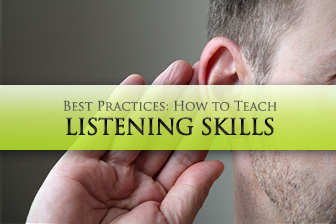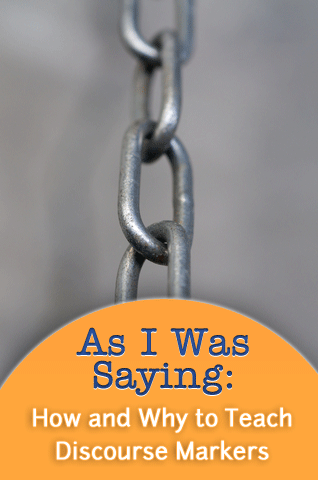How to Teach Listening Skills: Best Practices


These markers are important in connecting parts of the discourse as well as contributing to fluency. In addition, they guide the listener or reader in the direction of the discourse. For example, they signal the speaker’s or writer’s desire to open or close a conversation. They exist in both written as well as conversational language, and there are both formal and informal markers.
Students need to know discourse markers because they are important clues in the change of direction in a lecture, a conversation, or essay. For example, it can be nearly impossible to enter or exit a conversation in American English without some discourse marker like “I just want to say…” or “Anyway…” (In my particular dialect of California English, the stress is on the second syllable in the latter, and there is a long pause following, indicating the speaker’s desire to draw the conversation to a close or to move on to the next topic.) It is also important to learn which markers are more appropriate to writing or speaking. More than once I’ve had a student turn in a paper with the conversational marker “Last time I checked” (as in “Last time I checked, we have free speech in this country”), when the more appropriate marker would be “In my experience…” or “To my knowledge…” in a formal paper. Knowing discourse markers is important to fluency and appropriateness.
Let’s begin by identifying some common discourse markers and their functions.

As I was Saying… (to bring the conversation back to a former point)
Anyway… (to move on to another point or to close a conversation)
Here’s the thing/The thing is… (to raise an important issue)
I’m glad you brought that up because… (to add onto a point just raised)
At the end of the day... (to conclude an argument)
On the other hand… (to move to an opposing viewpoint)
In the case of… (to introduce an example)
In addition to… (to raise a new point or example)
From another perspective… (to introduce an opposing or different viewpoint)
In the final analysis…. (to conclude)
Raise awareness. Call attention to discourse markers while reading or listening to conversations or lectures. Once students start paying attention, they’ll be surprised how often these are used in both formal and informal situations. Just as an example, in the TV series, “Monk,” popular in the first decade of this millennium, the title character Adrian Monk, a former police detective with a series of mental health concerns like Obsessive Compulsive Disorder, has the verbal tic of using the marker, “Here’s the thing,” usually when introducing one of his obsessions to an unsympathetic audience. Playing a clip from a TV series like this to your class can get them to notice discourse markers in speech.
Have students look for discourse markers in readings. Call attention to how a writer opens a piece, moves on to another point, introduces a counterpoint, and concludes. Discuss how effective the writer is in the use of discourse markers and what might be more effective.
Have students match discourse markers to their meanings. After students have had some practice recognizing markers in both spoken and written discourse, have them match cards with the discourse marker on one card and its definition/function on other. In this way, students are clarifying and making explicit what they have implicitly learned through exposure.
Delete markers from extended prose. Have students make substitutions. The next step would be to take a couple of paragraphs of written discourse, delete the markers, and see how well students fill in the deletions. Have them compare their answers with each other and then go over the paragraphs with a class as a whole. It can be surprising how many “right” answers students will come up with for each item: often more than one marker will work well in the same situation.
Jumbled words: have students create discourse markers out of a stack of word cards. Have them practice the markers they came up with in a couple of sentences.
Give out a list. Ask students to practice using the discourse markers on the list in conversation and writing. Challenge them to include at least three discourse markers in their next journal or other writing assignment.
Write some dialogue. Have students write a conversation between two friends in the cafeteria, or a husband and wife at dinner, and so forth. Give students the basic situation and perhaps topic of conversation (weekend plans, finals, etc.), and have them write the conversation. Tell them to include at least three conversational markers.
Perform the dialogue. Once their dialogues have been written and checked by the teacher, have volunteers perform. Have the class comment on the use of markers and how realistic they seemed: too formal or informal, for example.
Assign writing with markers. When giving their next essay assignment, have students include three markers per paragraph/10 markers per paper, or whatever number is right for you.
Have students edit each other’s work. Sometime when my writing appears in print, I’ll notice problems with it I didn’t see before, especially if I didn’t have someone else look it over. Even experienced writers need a second pair of “eyes” on their work because we are not objective about our own work and tend to see what we think we wrote rather than what we actually wrote. Before turning in their papers, students should trade papers with a peer and edit each other’s work, specifically focusing on markers. Have students circle areas of concern in peers’ papers and discuss at the end. The role of a peer editor is not to correct work but to be a second pair of “eyes.”
It is through discourse markers that we move and signal the direction of the conversation or writing. Knowing their correct use will help students function well in English.